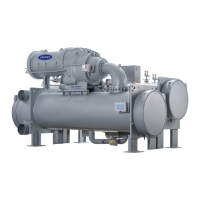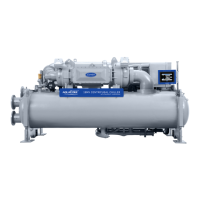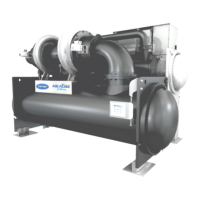23
If the readings are unsatisfactory, repeat the test at the
motor with the power leads disconnected. Satisfactory
readings in this second test indicate the fault is in the
power leads.
Carrier Comfort Network
®
Interface — The Car-
rier Comfort Network (CCN) communication bus wiring is
supplied and installed by the electrical contractor. It consists of
shielded, 3-conductor cable with drain wire.
The system elements are connected to the communication
bus in a daisy chain arrangement. The positive pin of each sys-
tem element communication connector must be wired to the
positive pins of the system element on either side of it. The
negative pins must be wired to the negative pins. The signal
ground pins must be wired to the signal ground pins. See instal-
lation manual.
NOTE: Conductors and drain wire must be 20 AWG
(American Wire Gage) minimum stranded, tinned copper.
Individual conductors must be insulated with PVC, PVC/
nylon, vinyl, Teflon
1
, or polyethylene. An aluminum/poly-
ester 100% foil shield and an outer jacket of PVC, PVC/
nylon, chrome vinyl, or Teflon with a minimum operating
temperature range of –4°F to 140°F (–20°C to 60°C) is
required. See Table 6 for cables that meet the requirements.
Table 6 — Manufacturers and Cable Numbers
When connecting the CCN communication bus to a system
element, a color code system for the entire network is recom-
mended to simplify installation and checkout. The color code
shown in Table 7 is recommended.
Table 7 — Recommended Color Code
Inhibitor Charge — The inhibitor charge is included
with the 19DV unit supplied by the factory. See Fig. 19 for
field inhibitor addition assuming compressor running and
negative cooler pressure. The factory pulls a vacuum then
closes the three (3) ball valves on the lubrication assembly
as shown in Fig. 20. An inhibitor charge is then injected us-
ing one of the off-center Schrader valves on the cover of the
strainer assembly. A yellow tag is located at each ball valve
indicating NOT to open the valves until the unit has been
charged with refrigerant to avoid inadvertently pulling the
inhibitor out of the refrigerant system. A dose of Carrier in-
hibitor is supplied in the lubrication assembly by the facto-
ry. An additional dose is to be added in the field as part of
chiller commissioning.
Suggested Procedure:
1. Locate inhibitor bottles strapped to the lube assembly by
the factory (total supplied inhibitor quantity will be ap-
proximately 1 US Qt/1.0 L).
2. Ensure availability of appropriate PPE such as protec-
tive gloves/protective clothing/eye protection/face pro-
tection and wash throughly after handling.
3. After refrigerant has been added and the inhibitor fac-
tory charge has been allowed to mix with the refriger-
ant add the factory-supplied inhibitor through the
evaporator refrigerant charging valve. The evaporator
will be in a vacuum when unit is running so the inhibi-
tor charge will be sucked in. See Fig. 19.
4. Refrigerant charge hose can be used for inhibitor
charging purposes or a hard pipe creating a funnel us-
ing a 90 degree 2-in.x
1
/
2
-in. NPT female elbow reduc-
er along with a 2-in. NPT pipe to create a reservoir
(add inhibitor as it is being sucked into the cooler and
close
1
/
2
-in. charging ball valve prior to air being
sucked into chiller). Ensure that parts used to add in-
hibitor are clean to avoid any chiller contamination.
Fig. 19 — Inhibitor Addition
1. Teflon is a registered trademark of DuPont.
MANUFACTURER CABLE NO.
ALPHA 2413 or 5643
AMERICAN A22503
BELDEN 8772
COLUMBIA 02525
SIGNAL
TYPE
CCN BUS CONDUCTOR
INSULATION COLOR
CCN TERMINAL
CONNECTION
+ Red Red (+)
GROUND White White (G)
– Black Black (–)
WARNING
BE AWARE that certain automatic start arrangements can
engage the starter. Open the disconnect ahead of the starter
in addition to shutting off the chiller or pump. Failure to
follow this procedure may result in personal injury by elec-
tric shock.
WARNING
The main disconnect on the starter front panel may not
de-energize all internal circuits. Open all internal and
remote disconnects before servicing the starter. Failure
to follow this procedure may result in personal injury by
electric shock.
Cooler
½" NPT charging valve
½" x 2" NPT reducer elbow or alternate adapter
2" NPT pipe
or alternate container

